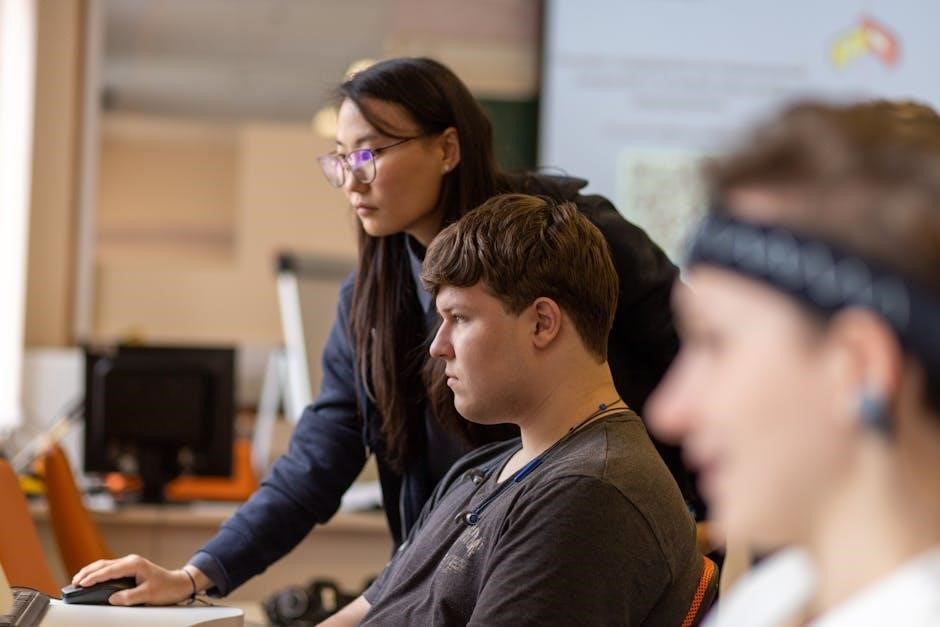
Disadvantages of Computer-Assisted Instruction

While computer-assisted instruction offers benefits, it also has notable downsides. It can struggle to provide truly personalized learning experiences, limit immediate human-like feedback, and create psychological pressure for students to adapt to technology-driven environments.

Computer-Assisted Instruction (CAI), also known as Computer-Based Learning (CBL) or Computer-Managed Instruction (CMI), is an educational approach that leverages technology to deliver structured learning experiences. It has gained popularity since the early 1990s, offering a modernized form of education within the EdTech industry. CAI utilizes devices such as desktops, tablets, and mobile devices to provide interactive and often personalized learning opportunities. The method is designed to complement traditional teaching by offering students engaging and interactive lessons, allowing them to learn at their own pace. Despite its name, CAI involves a range of tools and technologies, making it a versatile option for diverse educational settings. However, while CAI is praised for its efficiency and convenience, it also presents several challenges that educators and learners must consider. This section provides an overview of CAI, highlighting its role in contemporary education and setting the stage for a deeper exploration of its limitations.
Potential for Distraction
One significant disadvantage of Computer-Assisted Instruction (CAI) is its potential to distract students, undermining the learning process. When technology is integrated into classrooms, students often find themselves divided between focusing on the instruction and exploring the capabilities of their devices. This can lead to reduced attention spans and decreased learning effectiveness. For instance, students might use their devices for non-academic purposes, such as browsing the internet, checking social media, or playing games, instead of engaging with the lesson. Furthermore, the interactive nature of CAI tools, while engaging, can sometimes be overwhelming, causing students to lose track of the primary educational objectives. This distraction is particularly problematic in environments where students lack self-discipline or proper supervision. As a result, the classroom atmosphere may become less focused, hindering the overall efficiency of the instruction. Thus, while CAI offers innovative ways to deliver education, its potential to distract students remains a notable concern for educators aiming to maintain a productive learning environment.
High Costs
One of the most significant drawbacks of Computer-Assisted Instruction (CAI) is its high cost, which can create a financial burden for educational institutions. Implementing CAI requires substantial investments in hardware, such as computers, tablets, and other devices, as well as software tailored to specific educational needs. Additionally, the cost of maintaining and updating these technologies is ongoing, as software becomes outdated and hardware requires regular replacements. Schools and universities, especially those in resource-limited areas, often struggle to allocate funds for these expenses. Furthermore, the development of customized CAI programs can be particularly costly, as they may involve hiring specialized programmers or purchasing licenses for proprietary software; The financial strain is further exacerbated by the need for teacher training to ensure effective use of these tools. As a result, the high costs associated with CAI can limit its accessibility, creating disparities in education between institutions with varying financial capabilities. This economic challenge underscores the need for careful planning and budgeting when considering the adoption of CAI in educational settings.
Dependence on Technology
One of the significant drawbacks of Computer-Assisted Instruction (CAI) is its heavy reliance on technology, which can lead to disruptions in the learning process. Technical issues such as software glitches, hardware malfunctions, or power outages can halt instruction, creating challenges for both teachers and students. Additionally, the need for consistent internet connectivity can be a barrier, especially in areas with unreliable access. This dependence on technology can also lead to a lack of flexibility, as lessons often require specific tools to function effectively. Furthermore, the constant need for updates and maintenance can strain resources and create downtime. Over-reliance on technology can also reduce students’ ability to develop problem-solving skills independently, as they may depend too heavily on digital tools. This vulnerability highlights the importance of having backup plans and ensuring that educators are prepared to adapt when technical difficulties arise. Overall, the dependence on technology can undermine the stability and effectiveness of CAI in educational settings.
Limited Human Interaction
Computer-Assisted Instruction (CAI) often reduces face-to-face interaction between students and teachers, which can hinder the collaborative learning process. While technology provides structured lessons, it lacks the spontaneity and emotional connection of human interaction. This can make learning feel impersonal, as students may miss out on nonverbal cues, such as body language and tone of voice, that are crucial for understanding and engagement. Additionally, the absence of immediate human feedback can slow the clarification of doubts, potentially affecting comprehension. The limited interaction also reduces opportunities for peer-to-peer collaboration, which is vital for developing social and communication skills. Over-reliance on CAI can lead to isolation, as students focus solely on screens rather than engaging with others. This lack of human connection can make learning less engaging and less effective for students who thrive on interpersonal interactions. As a result, while CAI offers convenience, it may fall short in fostering the social and emotional aspects of education that human interaction provides;
Technical Issues
Technical issues are a significant downside of computer-assisted instruction (CAI). Software glitches, compatibility problems, and system crashes can disrupt learning sessions, frustrating both students and educators. Additionally, reliance on stable internet connectivity means that outages or slow speeds can halt progress. Hardware malfunctions, such as faulty computers or peripherals, further exacerbate these challenges. Maintenance and updates also pose difficulties, as outdated systems may fail to support modern educational software. Furthermore, technical difficulties can create a digital divide, as not all students may have access to the same level of technology outside the classroom. These issues highlight the vulnerability of CAI to technological failures, which can undermine its effectiveness and create barriers to learning. Addressing these challenges requires robust infrastructure, regular maintenance, and contingency plans to ensure uninterrupted access to educational resources.

Limited Individualization
One of the significant disadvantages of computer-assisted instruction is its limited ability to provide truly personalized learning experiences. While CAI programs can offer structured lessons, they often fail to fully adapt to the unique needs, pace, and learning style of each student. This can result in a one-size-fits-all approach, where students who require additional support or enrichment may not receive the tailored attention they need. For instance, advanced learners might find the material too basic, while struggling students may feel overwhelmed by the lack of human-like guidance. Additionally, the inability of CAI to understand the nuances of individual learning preferences can lead to disengagement or boredom. Unlike human instructors, who can dynamically adjust their teaching methods, CAI systems rely on pre-programmed algorithms that may not account for diverse cognitive abilities or learning objectives. This limitation can hinder academic progress and creativity, making it less effective for students with special needs or those requiring extra challenges. Thus, while CAI offers convenience, its inability to individualize learning experiences remains a notable drawback.
Outdated Software
Another notable disadvantage of computer-assisted instruction is the rapid obsolescence of software and technology. Educational software often becomes outdated quickly due to advancements in technology, which can render existing programs incompatible with newer systems or devices. This can create significant challenges for schools and institutions, as updating or replacing software requires substantial time and resources. Outdated software may lack the interactive features, multimedia elements, and modern user interfaces that engage students, leading to a less effective learning experience. Furthermore, reliance on outdated systems can hinder the integration of new teaching methods and tools, limiting the potential benefits of technology in education. The financial burden of constantly updating software can also be prohibitive, particularly for institutions with limited budgets. As a result, students may be forced to use antiquated programs that fail to meet their learning needs or prepare them for the digital demands of the modern world. This issue underscores the importance of sustainable and adaptable technological solutions in educational settings.
Lack of Feedback
One significant drawback of computer-assisted instruction is the lack of immediate and meaningful feedback. While CAI systems can provide automated responses to certain tasks, they often fail to deliver the depth and context that human instructors can offer. For instance, complex queries or open-ended questions may not receive the detailed explanations or corrections that students need to fully understand their mistakes. This limitation can hinder the learning process, as students may not grasp where they went wrong or how to improve. Additionally, speech recognition software, which is commonly used in CAI, may struggle to provide accurate feedback on oral tasks, further reducing its effectiveness. Without personalized and timely feedback, students may feel disconnected from the learning process, leading to frustration and a lack of progress. This highlights the importance of balancing technology with human interaction to ensure that learners receive the guidance they need to succeed. The absence of robust feedback mechanisms remains a critical challenge in the implementation of CAI systems.

Psychological Pressure
Computer-assisted instruction can impose significant psychological pressure on students, particularly in high-stakes learning environments. The reliance on technology-driven platforms often creates a competitive atmosphere, where students feel compelled to keep up with the pace of automated lessons. This pressure can lead to heightened stress levels, especially for those who may struggle with adapting to new software or understanding complex digital tools. Additionally, the lack of human empathy in automated systems can exacerbate feelings of anxiety, as students may fear judgment or embarrassment when making mistakes. The constant need to perform well in a technology-monitored setting can also foster a fear of failure, discouraging students from exploring creative solutions or taking risks in their learning. Over time, this psychological strain can negatively impact motivation and overall academic performance. It’s crucial to address these pressures by incorporating supportive measures that balance technology use with human interaction and understanding, ensuring that students feel comfortable and confident in their learning journey.
Over-Reliance on Technology
One significant disadvantage of computer-assisted instruction is the potential for over-reliance on technology, which can hinder the learning process. When students and educators depend too heavily on digital tools, they may lose sight of traditional teaching methods that emphasize critical thinking and problem-solving. This over-reliance can lead to a lack of proficiency in basic skills, as students may rely on software to complete tasks rather than developing their own abilities. Additionally, technical issues such as software glitches, internet outages, or hardware malfunctions can disrupt learning entirely, leaving students and teachers unprepared. Over-reliance on technology also risks creating a generation of learners who are less adept at independent thinking and more comfortable with automated solutions. Furthermore, the high costs of maintaining and updating technology can strain educational budgets, diverting resources away from other essential areas. This over-dependence on technology can ultimately undermine the holistic development of students, making it crucial to strike a balance between technological tools and traditional teaching methods.